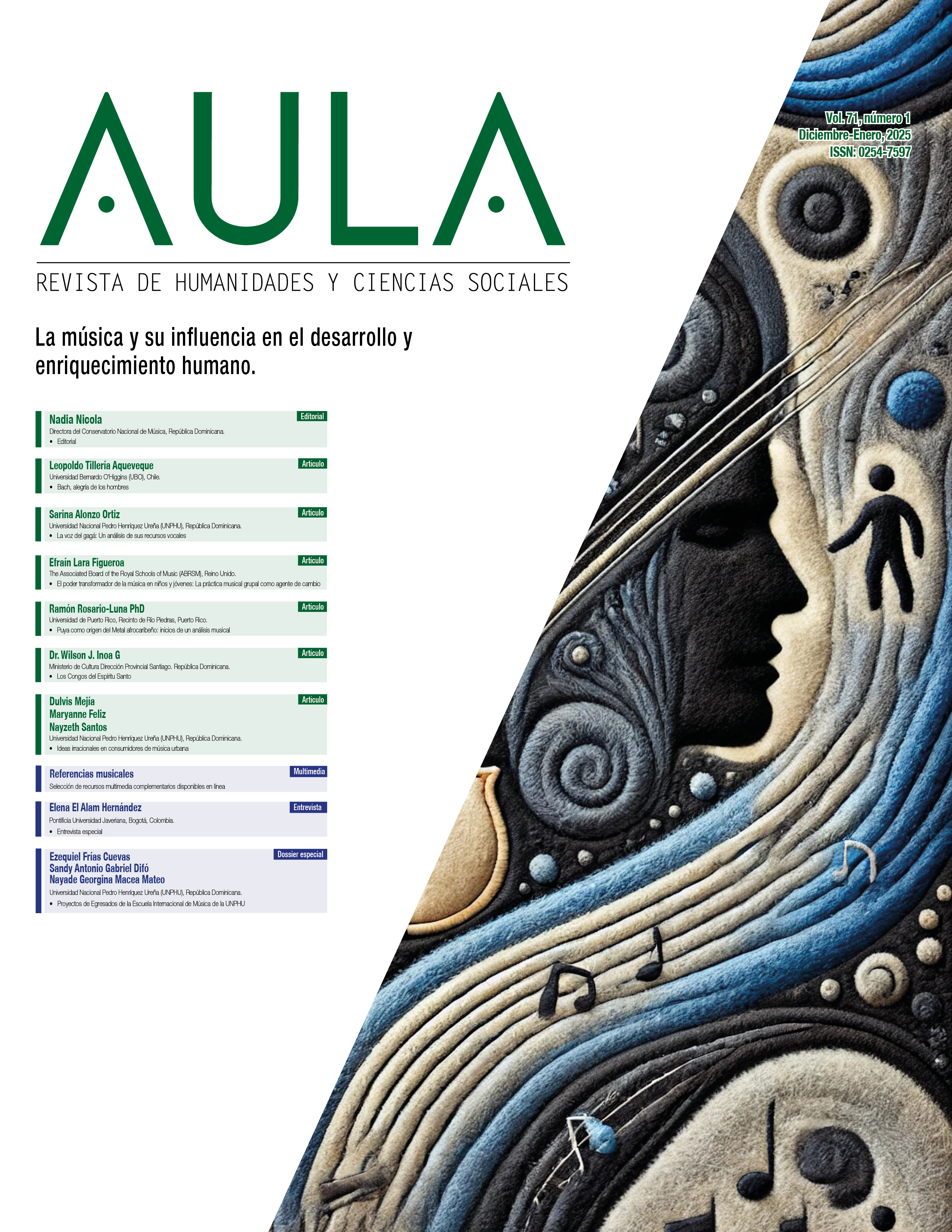Published 2025-01-01 — Updated on 2025-01-01
Keywords
- Bach, colossal, composition, icon, music, sacredness.
How to Cite
Copyright (c) 2024 AULA Revista de Humanidades y Ciencias Sociales

This work is licensed under a Creative Commons Attribution 4.0 International License.
Abstract
The resonance of Johann Sebastian Bach’s music, although it may seem a truism, exceeds the limits of the Baroque and reaches up to the present day, in the expression of his more than a thousand pieces, verging on perfection. This article aims to argue the thesis that the musical work of the German composer can be seen as a universal paradigm of the colossal and the sacred, aesthetic attributes that would make his legacy one of the moments of greatest epiphany in the history of music. With a methodological and theoretical nod to Derrida, the paper is carried out through a philosophical deconstruction, showing as its main result that The Well-Tempered Clavier and the chorale Jesus bleibet meine Freude [Jesu, Joy of Man’s Desiring], would be, in effect, iconic expressions of the colossal and the sacred, respectively. The way of approaching the thesis is ascribed, from the beginning, to a rather orthodox perspective, that is, recognizing that the possible colossal or the possible sacred in Bach’s work can only be truly corroborated through an interpretation attached to the composer’s genuine spirit, and this spirit only lives in the original score of each piece.
Downloads
References
- Bachiano (10 de noviembre de 2013). Bach Werke Verzeichnis. https://lc.cx/uzXept
- Bataille, G. (1997). El erotismo (A. Vicens & M. P. Sarazin, Trad.). Tusquets. (Trabajo original publicado en 1957).
- Bernardele, O. (2009). Del posmodernismo a la deconstrucción. Nobuko.
- Caillois, R. (1942). El hombre y lo sagrado (J. J. Domenchina, Trad.). FCE. (Trabajo original publicado en 1939).
- Cantaenmicrocosmos (11 de julio de 2020). «Jesus bleibet meine Freude» de Johann Sebastian Bach. https://lc.cx/Tl5GXw
- Derrida, J. (2001). La verdad en pintura (M. C. González & D. Scavino, Trad.). Paidós. (Trabajo original publicado en 1978).
- Derrida, J. (2013). La escritura y la diferencia (P. Peñalver, Trad.). Anthropos. (Trabajo original publicado en 1967).
- Espinoza, P. (2022). Textos, deconstrucción, espectros, hospitalidad. Apuntes sobre Jacques Derrida y la escritura de la historia. Historia y grafía (59), 15-57. https://doi.org/10.48102/hyg.vi59.392
- Estévez, R. (2016). El Clave bien temperado. J. S. Bach. Análisis estructurales de las 48 fugas: Una propuesta metodológica para Centros Superiores Musicales de Educación [Tesis de doctorado no publicada]. Universidad de La Laguna.
- Guerra, C. (2005). Recording Bach. En Epistemología y Estética (pp. 113-163). LOM.
- Guirao, S. (2015). Utilidad y tipos de revisión de literatura. Ene, 9(2), https://dx.doi.org/10.4321/S1988-348X2015000200002
- Kant, E. (1992). Crítica de la facultad de juzgar (P. Oyarzún, Trad.). Monte Ávila. (Trabajo original publicado en 1790).
- Krieger, P. (2004). La deconstrucción de Jacques Derrida (1930-2004). Anales del Instituto de Investigaciones Estéticas, 26(84), 179-188. https://lc.cx/bufZtU
- Martín, S. & Lafuente, V. (2017). Referencias bibliográficas: indicadores para su evaluación en trabajos científicos. Investigación bibliotecológica, 31(71), 151-180. https://doi.org/10.22201/iibi.0187358xp.2017.71.57814
- Milella, F. (26 de enero de 2015). Bach - Cantata BWV 147 “Herz und Mund und Tat und Leben”. Música en México. https://lc.cx/TacJze
- Mlinar, I. A. (2013). Lo sagrado y la desacralización. Teología y vida, 54(3), 509-521. http://dx.doi.org/10.4067/S0049-34492013000300006
- Montecino, A. (1960). Algunos apuntes sobre la interpretación del Clave Bien Temperado de J. S. Bach. Revista Musical Chilena, 14(69), 41-49. https://lc.cx/3Laj8G
- Mora, M. (01 de febrero de 2021). El clave bien temperado de Johann Sebastian Bach. Melómano. https://lc.cx/Xdry_S
- Netherlands Bach Society (10 de agosto de 2021). Bach - Jesus bleibet meine Freude from Cantata BWV 147 [Archivo de Vídeo]. Youtube. https://lc.cx/nzOh2L
- Pacotraver (28 de febrero de 2018). La fascinación. La nodriza de las hadas y el rey carmesí. https://lc.cx/kmBBD-
- Pakito Palote (01 de octubre de 2012). Bach, El clave bien temperado Libro 1 BWV 846-869. Robert Levin, teclado [Archivo de Vídeo]. Youtube. https://lc.cx/e4qgfl
- Pakito Palote (12 de octubre de 2012). Bach, El clave bien temperado Libro 2 BWV 870-893. Robert Levin, teclado [Archivo de Vídeo]. Youtube. https://lc.cx/XGgmew
- Redacción BITE (27 de octubre de 2023). De Lutero a Bach: cómo el luteranismo vivificó el canto congregacional. https://lc.cx/DHT--h
- Sagua, H. (2007). La referencia electrónica en artículos científicos. Revista médica de Chile, 135(7), 939-941. http://dx.doi.org/10.4067/S0034-98872007000700016
- Vaskes, I. (2007). La axiomática estética: deconstrucción. Ideas y Valores, 56(134), 3-21. https://lc.cx/aU3oDi


